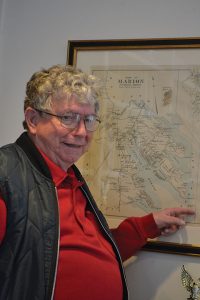Name: Pete Smith
Age: 82 (But he made us guess)
Lives in: Marion
How he got here: Born and raised…
Favorite Tri-Town place: “I kinda like this place,” he says gesturing with his hands inside the Sippican Historical Society Museum office at 139 Front Street. “I must. I’ve volunteered here for over twenty years.”
What he’d change if he were the president of Tri-Town: Marion specifically, Pete supposes he would like to see fewer historical homes being demolished and replaced – the most significant one, to him, being the Town House.
Ever seen a celebrity locally? Perhaps, but he can’t recall anyone specific. “I guess I wasn’t that impressed.”
Marion Treasure
By Jean Perry
Pete Smith is one of those people you might compare to, of all things, an onion – not because he makes you cry, but because no matter how many layers you peel back another layer is revealed, and then another interesting layer and then another layer that’s even more interesting than the last one you peeled back.
Take his name, for instance. Most people who see him say, “Hi, Pete!” and assume that Pete was his real name.
“Your name’s not Pete?” interjects a museum employee nearby within earshot of us sitting at the large conference table inside the cozy office of the Sippican Historical Society.
It’s actually not Pete, as most people who are familiar with the man associated with all things history in Marion think it is. It’s Charles. Charles “Pete” Smith, longtime member of the Sippican Historical Society, volunteer at the museum, and guy responsible for supplying a significant bulk of the historic Marion merchandise on display inside said museum.
Smith is synonymous with history in Marion. In fact, he was even recently referred to as “Mr. Marion” during a recent meeting of the selectmen, which was a surprise to Smith who claims he has never heard anyone call him ‘Mr. Marion.’
But the other question still remains in this name game – why ‘Pete,’ Pete?
“I don’t even know!” he says, although it’s hard to tell sometimes whether he’s telling the truth or joking. Charles “Pete” Smith can be rather cheeky – but in a pleasing way.
“I don’t really know why,” he repeats himself. “My middle name is Robert.”
Pete’s mother couldn’t even tell him why he was always called Pete or Peter, he says. “Or maybe there was a good reason and they didn’t want to tell me.”
“I asked my grandmother,” Pete says, “and I guess she’s the one that put down ‘Peter,’ and my mother liked the name Peter.” But, Pete says, according to his mother, his great-grandmother didn’t even like the name, which (off the record) says Pete, must have reminded her of some old slang from the time.
Anyway, Mr. Marion – ahem, Pete – knows more about the history of Marion than your average Marionite (or historian). He’s been a member of the historical society for well over 20 years now and was named curator roughly 11 years ago, although Pete himself didn’t seem to notice when that happened. He’s listed as the curator in the 2007 book he edited titled A Picture Postcard History of Marion Massachusetts, but couldn’t recall the official appointment.
“I surprise all of them with the things I know,” he says without a hint of arrogance, for it’s true – the guy is a treasure trove of Marion history.
But how does the man some people refer to as Mr. Marion come to know so much about the seaside town he and roughly 5,000 others call home?
“Because I’ve lived it,” says Smith. “Plus, if I didn’t experience it myself, I’m here (in the museum). You can’t keep filing papers on everything without learning something about it.”
We’ve already established that Smith has lived in Marion his whole life – from attending Sippican School and then Tabor Academy, while leaving Marion for four years to join the Navy. He got his degree in business from Nichols College in Dudley, MA, and returned to Marion and worked for the Babbit Steam Specialty Company in New Bedford. He was also a special officer for the Marion Police Department for 20 years.
In addition, he’s stood in practically every social arena in town – the Council on Aging, the Lions Club (when there still was one in Marion), the Masons, the historical society, of course, and is also part of the Charles R. Washburn Memorial Trust board, serving as the treasurer.
“I’m treasurer of every darn thing I get into,” said Smith strangely enough. “Maybe they think I’m honest?” He shakes his head in wonder, oblivious of any significance.
You see, Smith might always be the ‘treasurer,’ but Smith is also a collector of ‘treasures’ – old postcards, antiques – especially antiques that originate from Marion or are associated with Marion. He goes out, a treasurer in search of treasure, often to flea markets where he’s found many a unique gem or to auctions where he’s encountered some pretty cool stuff, usually with a heavier price tag.
There is a colorful collection of souvenir china from places like the Sippican Hotel and Casino that Smith collected and donated to the museum. He’s also donated post cards like the ones featured in the aforementioned book.
“I’ve got tons of them!” said Smith, admitting that he’s got even more at home, and most of the Marion-centric antiques he’s collected he still keeps at home, too. “When I’m out and about if I see anything from Marion that I don’t have, it’s mine.”
There is a gold-leaf mirror featuring a painting of Eastover Farm on the office wall, purchased for $99 (a steal) and donated by Smith, as well as some local ship passports signed by various presidents – including President Martin Van Buren (“When have you ever seen something signed by Van Buren,” Smith asks in after-the-fact astonishment) that he helped acquire.
“Most people don’t realize it, but I collect anything, really – that looks good – about Marion’s history,” Smith said. Some items he has donated to the museum, some he has out on loan, “And there’s some of it they’re not going to get until I’m gone,” he adds, citing job security.
Smith knows everything there is to know about Marion history that’s knowable, of course. For instance, all of the information surrounding the Mary Celeste aka “The Ghost Ship” that is available – aside from the actual fate of the people who disappeared from the boat without a trace – Smith knows. It’s even possible that he knows what happened to them and he’s holding out on us. But you get the picture. He’s a living, walking, breathing history book on Marion.
It’s no wonder Selectman Jody Dickerson recently brought up the idea of officially appointing Smith as the Town of Marion’s appointed historian. (Speaking of selectmen, having been a lifelong resident, Smith says he’s known many of them since they were kids – but we will save that for another story…)
Smith knows history. “Marion history,” he says specifically. The rest of history he doesn’t reserve much of his time for. His passion lies in the Marion of the Golden Era, “when all the celebrities came to Marion,” he said.
“I’d like to have lived during that era, really,” he said.
Smith’s dedication to preserving Marion’s history is self-evident. He spends a lot of time seeking out relics from Marion’s past, chasing the ghosts of Marion’s hallways of history. And Smith knows about ghosts, just ask him about his table-tipping incident and the fact that if he ever has to come into the historical house that is home to the museum alone at night, “Let’s just say I’m in and out real quick.”
As much as Smith knits together the threads of Marion’s history to dress up our curiosity, Smith himself (or at least his ancestors) really did make up the fabric of the town’s history. Remember that little two-part history number The Wanderer published in the June 25, 2015 edition called “The Tar and Feather Incident” written by Kyle DeCicco-Carey? (If not, you can view Part One at www.wanderer.com/features/the-tar-and-feather-incident-2/).
Well, says Smith, Clara Mendel Potter was his great-grandmother.
And if you’re still wondering what’s so fascinating about the guy Pete Smith, check out his identification card for the Council of Seven Royal House Pokanoket Tribe. You don’t get to carry this card unless you’re one of seven chosen few who are descendants of royalty – Native American royalty – a descendant of Chief Quadequinah, brother of Chief Massasoit, the two kings that met Captain Thomas Dermer at Pokanoket in May 1619.
Ancestral roots in these parts don’t run that much deeper.
Smith says his memory isn’t what it used to be and he actually warned about that just a few days before his interview, prophesying that he would likely forget all about it on Tuesday morning. Which he did, of course, not to his surprise. The trouble with losing your memory, he said, is that there’s no one besides him willing to remember Marion’s past.
“Problem is, I have an interest in the town and its history, and more than most people do today,” said Smith.
And he’s still got so much left to discover, he says. For instance, why was one section of land at Tabor Academy documented on a 1903 map of Marion as being named “Red Rock”? And where on Earth can he find photographs of the artillery that was once out at Kittansett?
How can you find out, I ask him?
“Keep asking,” said Smith. “You just keep asking.”
And you keep peeling, I think to myself. Keep pulling back those layers and another facet is revealed of the gem we call Pete Smith: Marion’s ubiquitous treasurer … Marion’s treasure hunter … Marion’s treasure.







